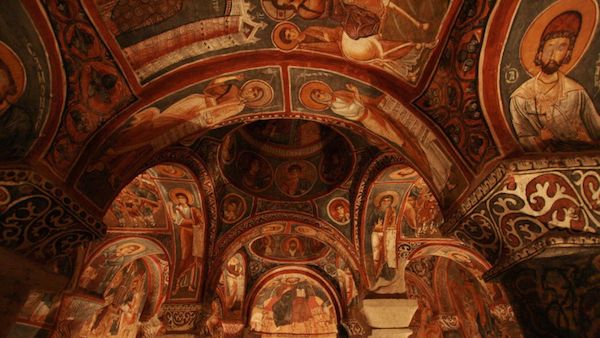Cappadocia is an ancient region of central Anatolia, famous for the peculiar formation of its land and its history dates back to the third geological period (millions of years ago). During this period, there was an inland sea surrounded by valleys and woodland, where, according to scientific findings, extinct animals used to live. This region is known as the Middle Anatolian Plateau, which was filled with masses of lava and ash after a series of volcanic eruptions caused by the surrounding mountains. The climatic changes that occurred on Earth during the following centuries (ice age) in combination with the volcanic eruptions prevented people from settling in this area. However, once the ice age ended, the landscape composed of lakes and volcanic materials eroded due to natural forces, leading to the creation of this peculiar landscape seen today.
At the same time, the melting snow created rivers, making this an ideal place to live. In addition, the huge rocky hills created a natural fortification, while the volcanic rocks became easier for humans to use. Consequently, people settled in the most fertile areas, around the rivers and lakes, as these were rich in water and animals for hunting. Lake Kizilirmak offered the people of Anatolia a suitable habitat for building their homes and organizing their lives on its fertile shores. It’s important to mention that the Konya valley was a lake during the period 16,000-8,000 BC, while Europe was in the ice age. Thus, Anatolia’s mild and humid climate facilitated agricultural activities due to the fertility of its land and, of course, the abundance of water. Around the same time, people started breeding animals and replaced their hunting activities with farming. The conditions for permanent residences, rather than moving from place to place, had been set. The next step was the creation of religions, for the first time in human history.
The origins of the name “Cappadocia”
A Persian inscription from the period of the Persian king Darius between 522-486 BC contains the word “Katpatuka”, which means Cappadocia in Persian. There are advanced opinions that interpret the word “Katpatuka” as “country of beautiful horses”. But there are also different views on the origin and meaning of the word. According to Prof. Dr. Bilge Umar, the word that gave rise to the name “Cappadocia” comes from Anatolia. He said that the name of Katpat, which forms the root of the word, is “Khepat” which is the mother goddess of the Hittites and “uka” which is the end of the word is a suffix that was widely used in the period to form names of peoples and nations. Khepatukh or Karpatuka means “Khepat people” or “Country of Khepat people”. This approach suggests that the first form of the word “Cappadocia” has Hittite origins and means “The country of the mother goddess Kerpat”. The word Khepatukh was later used as a form of Katpatuka by the Persian clans of Iran. Hellenistic society used this word as Cappadocia.
Cappadocia’s climate
The altitude of the Cappadocia region is around 1100 meters. It has a continental climate, where summers are hot and rainless and winters are cold and rainy. Winter starts in the first half of December and lasts until mid-March and brings snow, while spring brings rain. There is usually no rain during the summer and fall months.


0 Comment